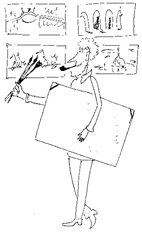
A Production Designer
Date: 2015-10-07; view: 1011.
B) Read the article and make sure you know all the highlighted words.
C) True, False or Not Given?
1) Making film sound is purely technological.
2) Sound designers are not part of the film crew.
3) It is the producer who hires the sound designer for the project.
4) The sound designer always works from beginning to end of every project.
5) Cooperation with the creative team is essential.
6) The sound designer always records new sound for the project.
7) The sound designer sometimes works with an orchestra to record music.
8) The majority of sound designers do not work full-time.
9) Each sound designer should have an extensive portfolio.
d) Follow-up: Go online, find some soundtracks and play them for the group. The other students should say what films they are from.
Exercise 63. a) Discuss the following questions:
- How often do you go to art-galleries?
- Which is more important: drama structure or aesthetics?
- Do you agree that all filmmakers should study art history?
- Do you know any biopics of famous artists?
A production designer is a person who works to create and establish the aesthetics of a production. These professionals may be responsible for developing the design for films, television (TV) programs, music videos or advertisements. Production designers might also be referred to as “art designers”, because key responsibilities of the positions can be similar or shared. 
Usually, a production designer is charged with the task of establishing the setting and style of a motion picture, including the overall design of sets. Before beginning a project, production designers might take time to create a design concept, which will influence subsequent decisions regarding the production's design. In certain situations, production designers might collaborate with directors when creating the concept. Regardless of whether the director's input is honored, the design concept will be used by art staff members to make production choices and create visuals. Sketches or conceptual models might illustrate the design concept and help staff members better understand and follow the concepts.
Production designers are expected to work in a collaborative capacity with those individuals above and below their positions in the project's hierarchy. For example, a production designer might confer with producers, directors and directors of photography to decide on a feel of a film while also working with set designers, set decorators, set dressers, property masters, graphic designers, model makers, costume designers and others to make their vision a reality. Production designers might also direct the locations manager, the hair and makeup stylists and the special effects director to ensure that all elements of a film are organized and tied together.
The ultimate responsibilities of a production designer can vary between projects and industries. In some productions, the production designer is almost wholly responsible for the project's aesthetics. In other productions, a production designer's responsibilities are reduced. Typically, production designers whose tasks are limited are often working under a director with established visual styles.
Those interested in pursuing a career in production design should have a working knowledge of the fundamentals of design. Students interested in pursuing production design might major in architecture, environmental design or theatrical set design. It's also suggested that future production designers develop communication skills, because an integral part of the job is to develop concepts and effectively communicate them to everyone from producers to production staff members. Graduates looking to begin a career in production design should consider becoming a production assistant for practical training. New graduates might seek job opportunities in student films, commercials or low-budget music videos.
| <== previous lecture | | | next lecture ==> |
| Film Sound Designer | | | SUMMARY |